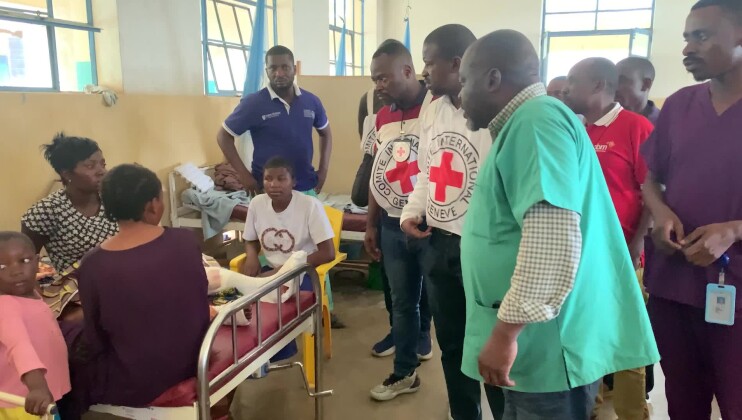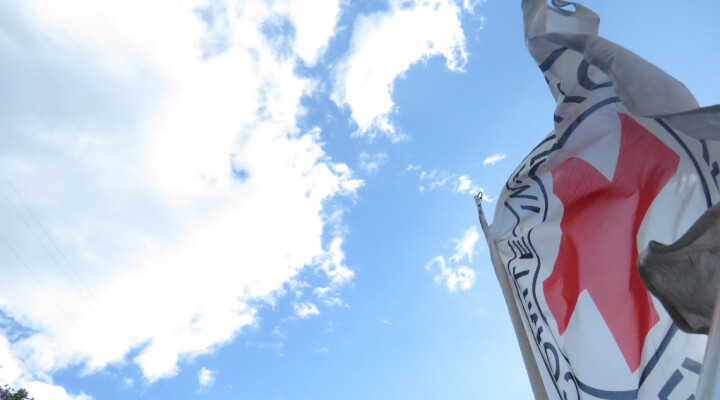Syria: Resiliance and Courage Amid Staggering Destruction
In Eastern Ghouta, the level of destruction is staggering. Hardly a building is undamaged. Hospitals, schools, shops, water and electricity services: none were spared in the conflict. And neither were Eastern Ghouta’s people. Trying to navigate what is left of his home town is especially difficult for 24 year old Bassam Qassem.
“I was injured on November 21 2016,” he says. “I was outside and a shell landed near me. The Syrian Arab Red Crescent helped me, they took me to the nearest treatment centre, where my leg was amputated.”
Bassam almost certainly owes his life to Red Crescent volunteers like Emad Eddin Hamed, who risked daily injury themselves to save others.
“Many medical staff, including me, were injured,” says Emad. “I got burns to my hands, face, and head. There is also shrapnel in my body. I will need surgery to get it removed.”
ICRC nurse Deborah Gallagher has experience working in conflict zones. Still, she was shocked by the conditions she found when she first arrived in what is currently Eastern Ghouta’s only public hospital.
“The operating theatre bed – which is often quite a complicated piece of medical equipment was literally a trolley that was fixed to the ground,” she explains. “That was barely able to, it was barely large enough to hold a person.”
“And the way in which they were having to ventilate patients and to keep them sedated for the surgeries was to sedate them with a sleeping agent and to manually use the bag, once they had put the tube in, to keep the patient breathing.”
Between 50 and 90% of Eastern Ghouta’s entire infrastructure has been destroyed. The ICRC’s director of operations Dominik Stilhart has been visiting the town of Harasta. It is said to be one of the least damaged areas, but the scale of the rebuilding work is still enormous.
“Look at the destruction around here,” he says. “It will take not just months but years just to clean all the rubble and to rebuild Harasta as it used to be before.”
But signs of improvement are slowly emerging, a testimony to the resilience and determination of the Syrians to get on with life, even though the conflict is not over yet. While many challenges still lie ahead, Deborah Gallagher can see that efforts are being made.
“Now we can see that the work is beginning to try to improve the conditions for the women and children and the people of these areas by the Ministry of Health,” she explains.
“And the ICRC will be doing our best to support these endeavours.”
Little by little, in the face of vast humanitarian needs, the people of eastern Ghouta are coming together – and starting to put their lives back together.
Despite the violence and grief they have endured, they have no intention, says Red Crescent volunteer Emad Eddin Hamed, of giving up and leaving his home town of Douma.
“Each one of us wants to help this country in a way, in this difficult situation,” he says.
“Of course, I will not quit. Danger is part of our job and we can get injured anywhere in the world. Douma’s situation was bad but things are getting better with time.”
KEY FACTS
- An estimated 350,000 people currently reside in Eastern Ghouta. It is estimated that before the crisis, up to 2 million people lived there, most of whom left after 2011.
- Between 50 and 90% of infrastructure has been destroyed during the conflict.
- There is only one partially functioning hospital for this population. All of Eastern Ghouta's 23 health facilities and 2 Syrian Arab Red Crescent health points were partially or totally destroyed during the conflict.
- The only source of drinkable water is a water trucking project supported by the SARC, the ICRC and the UN. The ICRC/SARC provided storage tanks and jerry cans to the 8 largest towns, with a population of approximately 250,000. This only serves half of the population in the area with a basic amount of water.
- At least half of the schools are not functioning.
For further information, please contact:
Ahmed Abughazala ICRC Damascus (Arabic and English) +963 930 336 718
Sarah Alzawqari ICRC Beirut (Arabic and English) +961 3 138 353
Iolanda Jaquemet ICRC Geneva (English and French) +41 79 447 37 26
Follow the ICRC on facebook.com/icrc and twitter.com/icrc
SHOTLIST
Location: Eastern Ghouta
Length: 4:42
Format: H264 HD
Camera: Ali Yousef
ICRC ref: AV921N_Syria
Filming date: 24/10/2018
Copyright: ICRC access all
0:00 – 0:32 Walking shot through destroyed streets
0:32 – 0:42 Bassam Qassem walking through streets on crutches
0:42 – 0:48 Another walking shot
0:48 – 1:05 Soundbite Bassam Qassem (original Arabic) “I was injured on November 21 2016. I was outside and a shell landed near me. The Syrian Arab Red Crescent helped me, they took me to the nearest treatment centre, where my leg was amputated.”
1:05 – 1:16 Ambulance driving through streets
1:16 – 1:33 Soundbite Emad Eddin Hamed, Syrian Arab Red Crescent (original Arabic) “Many medical staff, including me, were injured. I got burns to my hands, face, and head. There is also shrapnel in my body. I will need surgery to get it removed.”
1:33 – 1:38 Ruined streets from ICRC vehicle
1:38 – 1:46 interior hospital, destruction
1:46 – 2:16 soundbite ICRC medical delegate Deborah Gallagher “The operating theatre bed – which is often quite a complicated piece of medical equipment was literally a trolley that was fixed to the ground. That was barely able to, it was barely large enough to hold a person.
“And the way in which they were having to ventilate patients and to keep them sedated for the surgeries was to sedate them with a sleeping agent and to manually use the bag, once they had put the tube in, to keep the patient breathing.”
2:16 – 2:30 Tilt up exterior ruined building
2:30 – 2:36 Street destruction
2:36 – 2:46 walking shot rubble, destroyed household items
2:46 – 2:59 Soundbite Dominik Stilhart, ICRC Director of Operations “Look at the destruction around here. It will take not just months but years just to clean all the rubble and to rebuild Harasta as it used to be before.”
2:59 – 3:09 Hospital interior pan round, better equipment
3:09 – 3:19 Hospital interior, more supplies on shelves
3:19 – 3:27 Hospital interior, child being treated
3:27 - 3:39 Soundbite ICRC medical delegate Deborah Gallagher “Now we can see that the work is beginning to try to improve the conditions for the women and children and the people of these areas by the Ministry of Health. And the ICRC will be doing our best to support these endeavours.”
3:39 - 3:47 Women walking on street
3:47 – 3:52 Ruined street, man passes on bicycle
3:52 – 4:16 Soundbite Emad Eddin Hamed, Syrian Arab Red Crescent (original Arabic) “Each one of us wants to help this country in a way, in this difficult situation. Of course, I will not quit. Danger is part of our job and we can get injured anywhere in the world. Douma’s situation was bad but things are getting better with time.”
4:16 – 4:25 Men working in olive grove
4:25 – 4:36 Women and children arrive at school
4:32 – 4:42 Young boys on bikes



